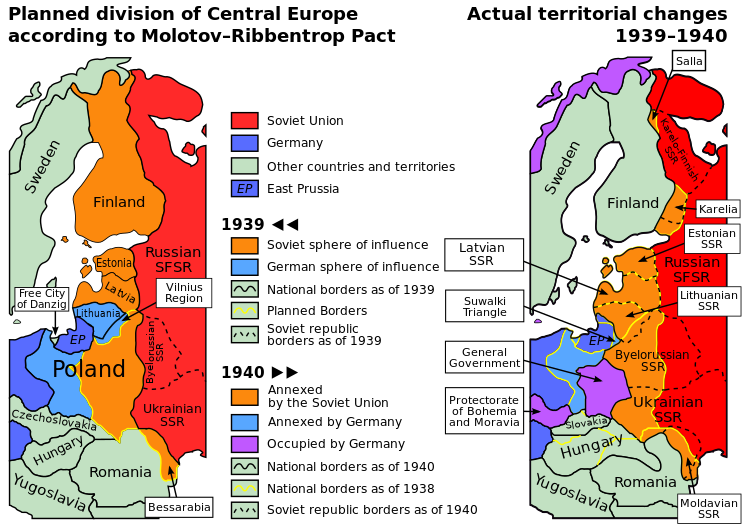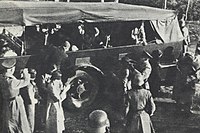Hey, did the German INVASION of the USSR give them a choice? Who broke the Molotov-Ribbentrop pact? Not the USSR - they were faithful allies of Nazi Germany as long as they were allowed to be. Yes, Stalin covered himself in glory, that's for sure.
....
In addition to stipulations of non-aggression, the treaty included a secret protocol that divided territories of Romania, Poland, Lithuania, Latvia, Estonia and Finland into Nazi and Soviet " spheres of influence", anticipating potential "territorial and political rearrangements" of these countries. Thereafter, Germany invaded Poland on 1 September 1939. The Soviet Union would not invade Poland until the Nomonhan incident was officially concluded by the Molotov– Togo agreement, which it was on 15 September 1939, taking effect on 16 September, at which time Stalin ordered Soviet forces to invade Poland on 17 September 1939. [3] Part of southeastern ( Karelia) and Salla region in Finland were annexed by the Soviet Union after the Winter War. This was followed by Soviet annexations of Estonia, Latvia, Lithuania, Bessarabia, Northern Bukovina and the Hertza region.
Of the territories of Poland annexed by the Soviet Union between 1939 and 1940, the region around Bialystok and a minor part of Galicia east of the San river around Przemysl were the only ones returned to the Polish state at the end of World War II. Of all other territories annexed by the USSR in 1939–40, the ones detached from Finland ( Karelia, Petsamo), Estonia ( Ingrian area and Petseri County) and Latvia ( Abrene) remained part of the Russian Federation, the successor state of the Soviet Union, after 1991. Nothern Bukovina, Southern Bessarabia and Hertza remain part of Ukraine.
.........

Ribbentrop and Stalin at the signing of the Pact
.........

....
Within the first few days of the invasion, Germany began conducting massacres of Polish and Jewish civilians and POWs. [98] [99] These executions took place in over 30 towns and villages in the first month of German occupation alone. [100] [101] [102] The Luftwaffe also took part by strafing fleeing civilian refugees on roads and carrying out an aerial bombing campaign. [103] [104] [105] [106] The Soviet Union assisted German air forces by allowing them to use signals broadcast by the Soviet radio station at Minsk allegedly "for urgent aeronautical experiments". [107]
...........
The Baltic States of Estonia, Latvia, and Lithuania were given no choice but to sign a so-called Pact of defence and mutual assistance which permitted the Soviet Union to station troops in them. [124]
The Soviet war with Finland and Katyn Massacre
.........
After the Baltic states were forced to accept treaties, [127] Stalin turned his sights on Finland, confident that Finnish capitulation could be attained without great effort. [128] The Soviets demanded territories on the Karelian Isthmus, the islands of the Gulf of Finland and a military base near the Finnish capital Helsinki, [129] [130] which Finland rejected. [131] The Soviets staged the shelling of Mainila and used it as a pretext to withdraw from the non-aggression pact. [132] The Red Army attacked in November 1939. [133] Simultaneously, Stalin set up a puppet government in the Finnish Democratic Republic. [134] The leader of the Leningrad Military District Andrei Zhdanov commissioned a celebratory piece from Dmitri Shostakovich, entitled " Suite on Finnish Themes" to be performed as the marching bands of the Red Army would be parading through Helsinki. [135] After Finnish defenses surprisingly held out for over three months while inflicting stiff losses on Soviet forces, the Soviets settled for an interim peace. Finland ceded southeastern areas of Karelia (10% of Finnish territory), [133] which resulted in approximately 422,000 Karelians (12% of Finland's population) losing their homes. [136] Soviet official casualty counts in the war exceeded 200,000, [137] while Soviet Premier Nikita Khrushchev later claimed the casualties may have been one million. [138]
At around this time, after several Gestapo–NKVD Conferences, Soviet NKVD officers also conducted lengthy interrogations of 300,000 Polish POWs in camps [139] [140] [140] [141] [142] that were, in effect, a selection process to determine who would be killed. [4] On March 5, 1940, in what would later be known as the Katyn massacre, [4] [143] [144] orders were signed to execute 25,700 Polish POWs, labeled "nationalists and counterrevolutionaries", kept at camps and prisons in occupied western Ukraine and Belarus. [145]
Soviets take the Baltics and Bessarabia[ edit]
Main articles: Occupation of the Baltic States and Soviet occupation of Bessarabia and Northern Bukovina
In mid-June 1940, when international attention was focused on the German invasion of France, Soviet NKVD troops raided border posts in Lithuania, Estonia and Latvia. [124] [146] State administrations were liquidated and replaced by Soviet cadres, [124] in which 34,250 Latvians, 75,000 Lithuanians and almost 60,000 Estonians were deported or killed. [147] Elections were held with single pro-Soviet candidates listed for many positions, with resulting peoples assemblies immediately requesting admission into the USSR, which was granted by the Soviet Union. [124] The USSR annexed the whole of Lithuania, including the Scheschupe area, which was to be given to Germany.
Finally, on 26 June, four days after France sued for an armistice with the Third Reich, the Soviet Union issued an ultimatum demanding Bessarabia and, unexpectedly, Northern Bukovina from Romania. [148] Two days later, the Romanians caved to the Soviet demands and the Soviets occupied the territory. The Hertza region was initially not requested by the USSR but was later occupied by force after the Romanians agreed to the initial soviet demands. [148]
Holocaust beginnings, Operation Tannenberg and other Nazi atrocities[ edit]
Main articles: Holocaust in Nazi-occupied Poland, Operation Tannenberg, and Nazi crimes against ethnic Poles
At the end of October 1939, Germany enacted the death penalty for disobedience to the German occupation. [149] Germany began a campaign of " Germanization", which meant to assimilate the occupied territories politically, culturally, socially, and economically into the German Reich. [150] [151] [152] 50,000–200,000 Polish children were kidnapped to be Germanized. [153] [154]


Polish hostages being blindfolded during preparations for their mass execution in Palmiry, 1940
Elimination of Polish elites and intelligentia was part of Generalplan Ost. The Intelligenzaktion, a plan to eliminate the Polish intelligentsia, Poland's 'leadership class', took place soon after the German invasion of Poland, lasting from fall of 1939 till spring of 1940. As the result of this operation in 10 regional actions were killed about 60,000 Polish nobles, teachers, social workers, priests, judges and political activists. [155] [156] It was continued in May 1940 when Germany launched AB-Aktion, [153] More than 16,000 members of the intelligentsia were murdered in Operation Tannenberg alone. [157]
Germany also planned to incorporate all land into the Third Reich. [151] This effort resulted in the forced resettlement of 2 million Poles. Families were forced to travel in the severe winter of 1939–40, leaving behind almost all of their possessions without recompense. [151] As part of Operation Tannenberg alone, 750,000 Polish peasants were forced to leave and their property was given to Germans. [158] A further 330,000 were murdered. [159] Germany eventually planned to move ethnic Poles to Siberia. [160] [161]
Although Germany used forced labourers in most occupied countries, Poles and other Slavs were viewed as inferior by Nazi propaganda, thus, better suited for such duties. [153] Between 1 and 2.5 million Polish citizens [153] [162] were transported to the Reich for forced labour, against their will. [163] [164] All Polish males were required to perform forced labour. [153] While ethnic Poles were subject to selective persecution, all ethnic Jews were targeted by the Reich. [162] In the winter of 1939–40, about 100,000 Jews were thus deported to Poland. [165] They were initially gathered into massive urban ghettos, [166] such as 380,000 held in the Warsaw Ghetto, where large numbers died under the harsh conditions therein, including 43,000 in the Warsaw Ghetto alone. [162] [167] [168] Poles and ethnic Jews were imprisoned in nearly every camp of the extensive concentration camp system in German-occupied Poland and the Reich. In Auschwitz, which began operating on 14 June 1940, 1.1 million people died. [169] [170]
Romania and Soviet republics[ edit]
Further information: Second Vienna Award, Population transfer in the Soviet Union, and Involuntary settlements in the Soviet Union
In the summer of 1940, fear of the Soviet Union, in conjunction with German support for the territorial demands of Romania's neighbors and the Romanian government's own miscalculations, resulted in more territorial losses for Romania. Between 28 June and 4 July, the Soviet Union occupied and annexed Bessarabia, Northern Bukovina and the Hertza region of Romania. [171]
............
en.wikipedia.org |




